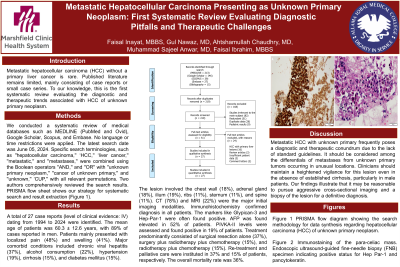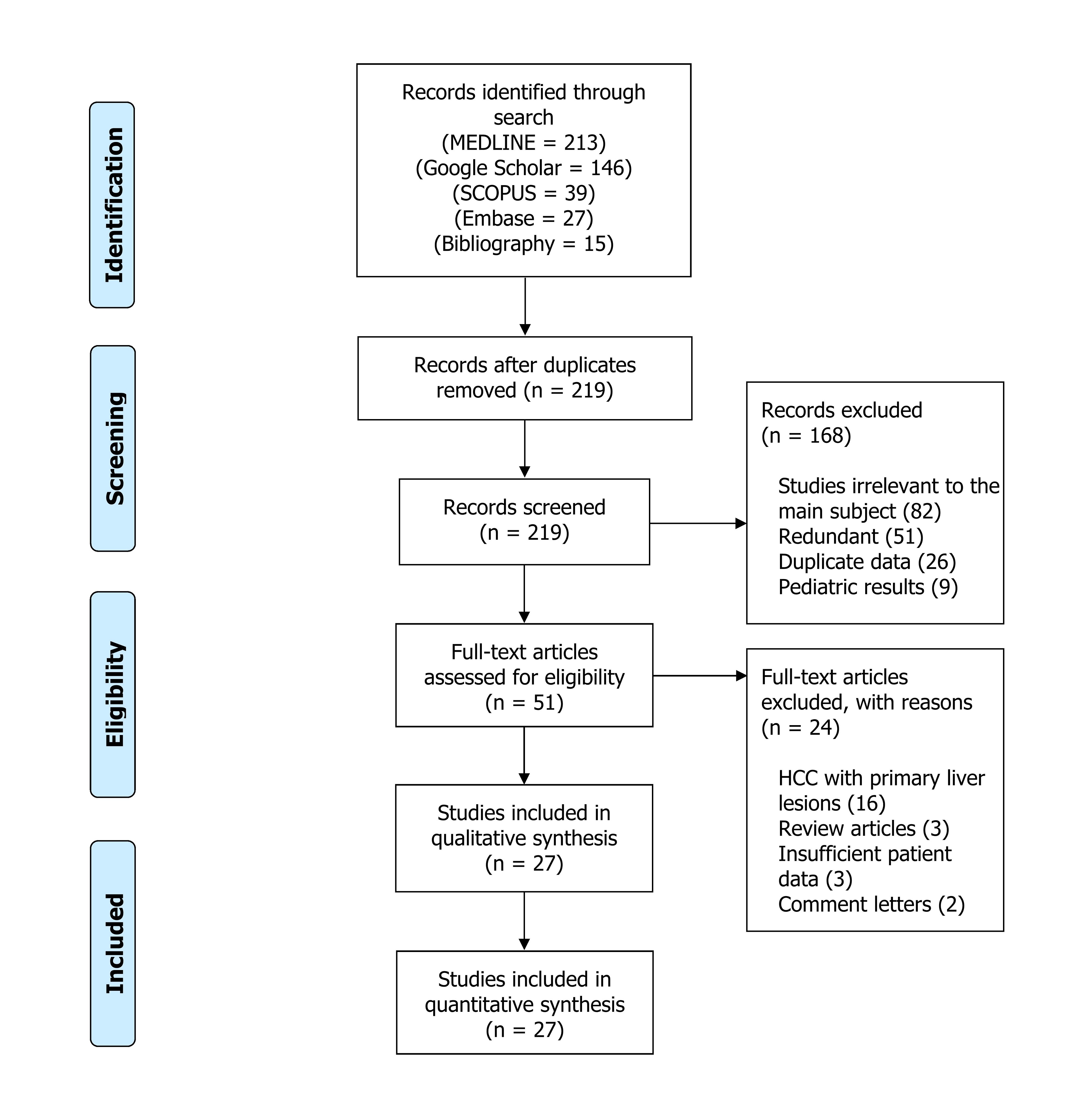Monday Poster Session
Category: Liver
P2885 - Metastatic Hepatocellular Carcinoma Presenting as Unknown Primary Neoplasm: First Systematic Review Evaluating Diagnostic Pitfalls and Therapeutic Challenges
Monday, October 28, 2024
10:30 AM - 4:00 PM ET
Location: Exhibit Hall E

Has Audio
- GN
Gul Nawaz, MD
Marshfield Medical Center
Marshfield, WI
Presenting Author(s)
Faisal Inayat, MBBS1, Gul Nawaz, MD2, Faisal Ibrahim, MBBS3, Muhammad Sajeel Anwar, MD4, Ahtshamullah Chaudhry, MD5
1Allama Iqbal Medical College, Lahore, Punjab, Pakistan; 2Marshfield Medical Center, Marshfield, WI; 3Wexham Park Hospital, Slough, England, United Kingdom; 4UHS Wilson Medical Center, Johnson City, NY; 5St. Dominic's Hospital, Jackson, MS
Introduction: Metastatic hepatocellular carcinoma (HCC) without a primary liver cancer is rare. To our knowledge, this is the first systematic review evaluating the diagnostic and therapeutic trends associated with HCC of unknown primary neoplasm.
Methods: We conducted a systematic review of medical databases such as MEDLINE (PubMed and Ovid), Google Scholar, Scopus, and Embase. No language or time restrictions were applied. The latest search date was June 05, 2024. Specific search terminologies, such as ''hepatocellular carcinoma,'' ''metastatic,'' and ''metastases,'' were combined using the Boolean operators ''AND,'' and ''OR'' with ''unknown primary neoplasm,'' ''cancer of unknown primary,'' and ''unknown,'' with all relevant permutations. PRISMA flow sheet shows our strategy for systematic search and result extraction (Figure 1).
Results: A total of 27 case reports (level of clinical evidence: IV) dating from 1994 to 2024 were identified. The mean age of patients was 60.3 ± 12.6 years, with 89% of cases reported in men. Patients mainly presented with localized pain (48%) and swelling (41%). Major comorbid conditions included chronic viral hepatitis (37%), alcohol consumption (22%), hypertension (19%), cirrhosis (15%), and diabetes mellitus (15%). The lesion involved the chest wall (18%), adrenal gland (18%), ilium (19%), ribs (11%), sternum (11%), and spine (11%). CT (78%) and MRI (22%) were the major initial imaging modalities. Immunohistochemistry confirmed diagnosis in all patients. The markers like Glypican-3 and Hep-Par-1 were often found positive. AFP was found elevated in 52% of patients. PIVKA-II levels were assessed and found positive in 19% of patients. Treatment predominantly consisted of surgical resection alone (37%), surgery plus radiotherapy plus chemotherapy (15%), and radiotherapy plus chemotherapy (15%). Re-treatment and palliative care were instituted in 37% and 15% of patients, respectively. The overall mortality rate was 36%.
Discussion: Metastatic HCC with unknown primary frequently poses a diagnostic and therapeutic conundrum due to the lack of standard guidelines. It should be considered among the differentials of metastases from unknown primary tumors occurring in unusual locations. Clinicians should maintain a heightened vigilance for this lesion even in the absence of established cirrhosis, particularly in male patients. Our findings illustrate that it may be reasonable to pursue aggressive cross-sectional imaging and a biopsy of the lesion for a definitive diagnosis.

Disclosures:
Faisal Inayat, MBBS1, Gul Nawaz, MD2, Faisal Ibrahim, MBBS3, Muhammad Sajeel Anwar, MD4, Ahtshamullah Chaudhry, MD5. P2885 - Metastatic Hepatocellular Carcinoma Presenting as Unknown Primary Neoplasm: First Systematic Review Evaluating Diagnostic Pitfalls and Therapeutic Challenges, ACG 2024 Annual Scientific Meeting Abstracts. Philadelphia, PA: American College of Gastroenterology.
1Allama Iqbal Medical College, Lahore, Punjab, Pakistan; 2Marshfield Medical Center, Marshfield, WI; 3Wexham Park Hospital, Slough, England, United Kingdom; 4UHS Wilson Medical Center, Johnson City, NY; 5St. Dominic's Hospital, Jackson, MS
Introduction: Metastatic hepatocellular carcinoma (HCC) without a primary liver cancer is rare. To our knowledge, this is the first systematic review evaluating the diagnostic and therapeutic trends associated with HCC of unknown primary neoplasm.
Methods: We conducted a systematic review of medical databases such as MEDLINE (PubMed and Ovid), Google Scholar, Scopus, and Embase. No language or time restrictions were applied. The latest search date was June 05, 2024. Specific search terminologies, such as ''hepatocellular carcinoma,'' ''metastatic,'' and ''metastases,'' were combined using the Boolean operators ''AND,'' and ''OR'' with ''unknown primary neoplasm,'' ''cancer of unknown primary,'' and ''unknown,'' with all relevant permutations. PRISMA flow sheet shows our strategy for systematic search and result extraction (Figure 1).
Results: A total of 27 case reports (level of clinical evidence: IV) dating from 1994 to 2024 were identified. The mean age of patients was 60.3 ± 12.6 years, with 89% of cases reported in men. Patients mainly presented with localized pain (48%) and swelling (41%). Major comorbid conditions included chronic viral hepatitis (37%), alcohol consumption (22%), hypertension (19%), cirrhosis (15%), and diabetes mellitus (15%). The lesion involved the chest wall (18%), adrenal gland (18%), ilium (19%), ribs (11%), sternum (11%), and spine (11%). CT (78%) and MRI (22%) were the major initial imaging modalities. Immunohistochemistry confirmed diagnosis in all patients. The markers like Glypican-3 and Hep-Par-1 were often found positive. AFP was found elevated in 52% of patients. PIVKA-II levels were assessed and found positive in 19% of patients. Treatment predominantly consisted of surgical resection alone (37%), surgery plus radiotherapy plus chemotherapy (15%), and radiotherapy plus chemotherapy (15%). Re-treatment and palliative care were instituted in 37% and 15% of patients, respectively. The overall mortality rate was 36%.
Discussion: Metastatic HCC with unknown primary frequently poses a diagnostic and therapeutic conundrum due to the lack of standard guidelines. It should be considered among the differentials of metastases from unknown primary tumors occurring in unusual locations. Clinicians should maintain a heightened vigilance for this lesion even in the absence of established cirrhosis, particularly in male patients. Our findings illustrate that it may be reasonable to pursue aggressive cross-sectional imaging and a biopsy of the lesion for a definitive diagnosis.

Figure: Figure 1. Preferred Reporting Items for Systematic Reviews and Meta Analyses (PRISMA) flow diagram showing the search methodology for data synthesis regarding hepatocellular carcinoma (HCC) of unknown primary neoplasm.
Disclosures:
Faisal Inayat indicated no relevant financial relationships.
Gul Nawaz indicated no relevant financial relationships.
Faisal Ibrahim indicated no relevant financial relationships.
Muhammad Sajeel Anwar indicated no relevant financial relationships.
Ahtshamullah Chaudhry indicated no relevant financial relationships.
Faisal Inayat, MBBS1, Gul Nawaz, MD2, Faisal Ibrahim, MBBS3, Muhammad Sajeel Anwar, MD4, Ahtshamullah Chaudhry, MD5. P2885 - Metastatic Hepatocellular Carcinoma Presenting as Unknown Primary Neoplasm: First Systematic Review Evaluating Diagnostic Pitfalls and Therapeutic Challenges, ACG 2024 Annual Scientific Meeting Abstracts. Philadelphia, PA: American College of Gastroenterology.
